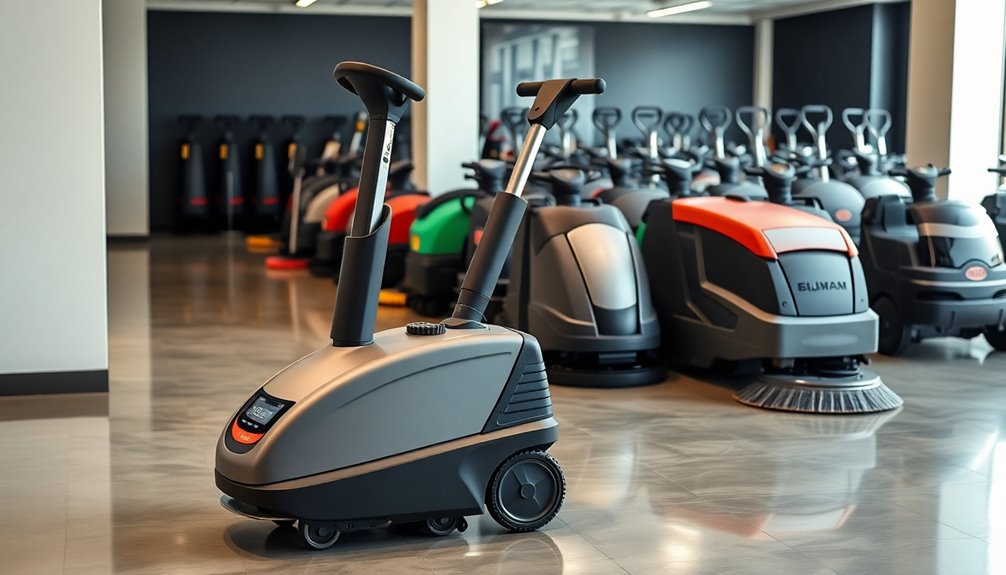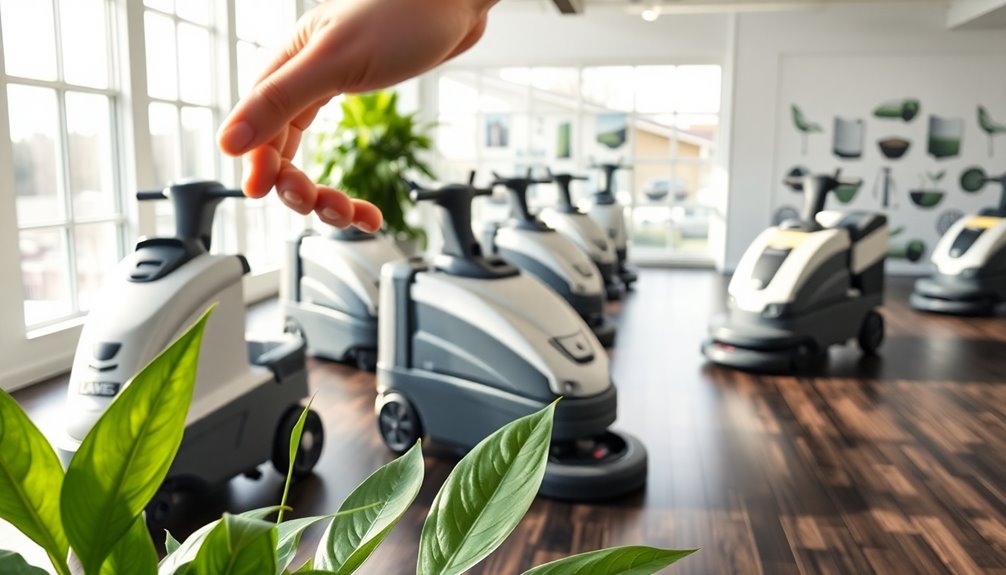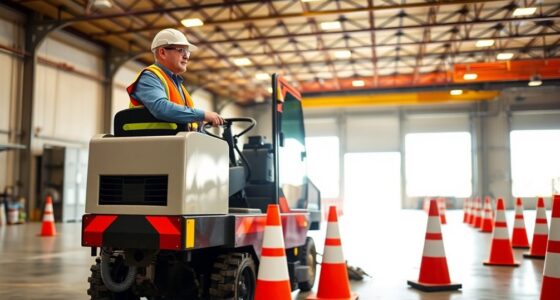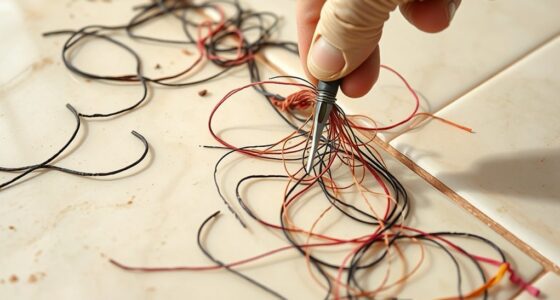To choose the right floor sweeper, start by assessing your space size and debris type. Consider whether a walk-behind or ride-on model fits your needs better. Look for key features like strong suction, ergonomic controls, and a good filtration system. Don't overlook operator comfort and maintenance requirements, as these can affect efficiency. Think about environmental impact too. Continue exploring to learn more about how these factors can enhance your cleaning operations.
Key Takeaways
- Assess the size and type of the area to determine if a walk-behind or ride-on sweeper is more suitable for your needs.
- Evaluate the debris types commonly found in your environment to select a sweeper with the appropriate sweeping system and filtration features.
- Consider operator comfort features, such as ergonomic controls and adjustable seats, to enhance productivity during long cleaning sessions.
- Prioritize sustainability by choosing energy-efficient models and those that minimize water usage and environmental impact.
- Review maintenance requirements and ensure you can easily manage regular upkeep to prolong the life of the sweeper.
Understanding Different Types of Floor Sweepers

When you're looking for an efficient way to keep your floors clean, understanding the different types of floor sweepers is essential. You've got walk-behind sweepers for small to medium areas, which are easy to maneuver. For larger spaces, ride-on sweepers offer comfort and efficiency, making longer cleaning jobs less tiresome. If you're tackling heavy-duty tasks in industrial settings, industrial sweepers are your best bet. Specialty sweepers cater to unique environments, while outdoor sweepers are designed to handle rough conditions and larger debris. Consider factors like working width, power supply, and brush type when making your choice. Each type has its purpose, so pick one that best fits your cleaning needs. Additionally, sweepers are suitable for both hard and soft floors, ensuring versatility in various cleaning environments.
Evaluating Area Performance

To ensure you choose the right floor sweeper, evaluating its area performance is vital.
First, focus on the cleanable surface area rather than just the total size of your space. Different sweepers have different capacities; for instance, industrial sweepers can clean between 15,000 to 25,000 square meters per hour, while ride-on options typically cover 8,000 to 15,000 square meters. Industrial sweepers are specifically designed for heavy-duty cleaning in large facilities, making them ideal for vast warehouses and factories.
Consider the specific needs of your environment—industrial sweepers are perfect for vast warehouses and factories, while ride-on models excel in efficiency.
Also, think about maneuverability in tighter areas, where walk-behind sweepers might be more effective.
Knowing these metrics will help you select a sweeper that matches your cleaning demands.
Key Features to Consider

After assessing area performance, it's time to consider the key features that make a floor sweeper effective in your specific environment.
First, think about the sweeping system; larger rotary brushes are better for lifting heavier debris, while side brushes help direct dirt to the center brush for efficient collection. Additionally, a floor sweeper's sweeping system is designed to provide optimal debris collection across various surfaces. A similar principle applies to best vacuum pool cleaners, which also utilize effective systems for thorough cleaning.
Don't overlook the suction system; strong suction and vacuum mechanisms are crucial for capturing finer particles, especially if air quality is a concern.
Look for a good filtration system, including HEPA filters, to keep the air clean.
Ergonomics also matter—choose a model with easy controls and a comfortable design to maximize productivity.
Lastly, ensure the debris hopper is large enough to minimize frequent emptying.
Identifying Suitable Applications

Identifying suitable applications for floor sweepers is crucial to ensuring you choose the right model for your needs.
For indoor spaces, consider warehouses and industrial areas where efficient cleaning of large surfaces is necessary. Retail stores, offices, and restaurants also benefit from sweepers that quickly remove dust and debris. In hospitals and schools, maintaining cleanliness is vital for health and safety. Keyword research tools can help you identify specific sweeper models suited for different indoor environments.
For outdoor applications, sweepers work well in parking lots, sidewalks, and streets, especially after construction. They're also effective in airports and ports for large area maintenance.
Each environment and surface type, from concrete to hardwood, requires specific features, so make sure to match the sweeper to its intended use for optimal performance.
Importance of Maintenance and Operation

Choosing the right floor sweeper goes beyond just selecting the model that fits your application; it also involves understanding the importance of maintenance and operation.
Regular maintenance is vital—emptying and cleaning the recovery tank daily keeps your machine running efficiently. Weekly checks, like adjusting brush pressure and lubricating moving parts, are essential to avoid costly repairs. Monthly inspections ensure everything works as it should. Proper training equips operators to perform maintenance and identify problems effectively.
Proper operation matters too; following manufacturer guidelines for speed and chemical use leads to optimal results. Make sure safety features are functional and choose the right pads or brushes to enhance cleaning efficiency.
Investing in maintenance software can streamline your tasks, helping you track usage and schedule maintenance, ultimately extending your sweeper's lifespan.
Budgeting for Your Purchase

When budgeting for your floor sweeper purchase, it's crucial to consider both upfront costs and long-term expenses.
Floor sweepers can range from $500 to $26,000, depending on the model and features. If you're managing a large area, a ride-on model might be more efficient, though more expensive. Electric sweepers are particularly advantageous for facilities over 1,000 square feet, as they can handle larger debris loads with ease.
Allocate your budget based on your facility size and the debris you'll be cleaning. Don't forget to factor in maintenance and operational costs, which can significantly affect your overall budget.
You can choose to buy, lease, or rent, each option having different financial implications. For ongoing needs, leasing often proves more economical than renting.
Prioritize equipment that offers long-term efficiency to maximize your investment.
Assessing Space Requirements

After establishing your budget, the next step involves evaluating your space requirements for a floor sweeper.
Start by measuring your aisles and storage areas. If you have narrow spaces, a compact sweeper will maneuver better and reach tight corners.
Consider the sweeping path width; wider paths clean faster but may not fit in your facility. Think about the layout—if it's cluttered, choose a model that can navigate around obstacles easily. A well-balanced sweeping path width is crucial to ensure efficiency while maintaining access to all areas.
Also, check if the sweeper can be disassembled for storage; this can save valuable space.
Finally, position your storage near central circulation areas to ensure quick access. Assessing these factors will help you select the right sweeper for your environment.
Choosing Based on Debris Type

Understanding the type of debris you'll be dealing with is crucial for selecting the right floor sweeper.
If you're managing light bulky debris like leaves or paper, vacuum sweepers are your best bet. They efficiently handle these materials, especially in shipping areas or outdoors.
For heavy dense debris, such as rocks found in industrial settings, broom sweepers are ideal, as they offer effective removal and dust control features. Additionally, these machines are suitable for both hard and soft floors, ensuring versatility in various environments.
In dusty environments, particularly in food processing or electronics manufacturing, broom sweepers excel by minimizing dust dispersal.
If you encounter mixed debris types, consider sweeper-scrubbers. These versatile machines can manage both light and heavy debris while sweeping and scrubbing various surfaces, making them perfect for large facilities with diverse cleaning needs.
Prioritizing Operator Comfort

Prioritizing operator comfort is essential for ensuring efficient cleaning operations. When selecting a floor sweeper, look for ergonomic controls that reduce fatigue during long shifts. Adjustable seats accommodate different sizes, enhancing comfort and minimizing strain. Features like backup cameras improve visibility, which promotes safety and reduces accident risks. Consider models with an automobile-style driver's seat for added comfort while operating. Reduced vibration in some sweepers further enhances the experience during extended use. Additionally, many Eureka ride-on sweepers come with an ergonomic seat that supports operator comfort during prolonged use.
Considering Environmental Impact

Operator comfort plays a significant role in maintaining efficient cleaning operations, but it's equally important to consider the environmental impact of your cleaning equipment.
Choosing a floor sweeper can significantly reduce water usage, enhance air quality, and minimize chemical reliance. Many modern sweepers are energy-efficient, lowering your carbon footprint while promoting quieter operations. Additionally, these machines often contribute to reduced water usage, allowing businesses to adopt more sustainable cleaning practices. Moreover, using energy-efficient machines helps support renewable energy sources, which further enhances your sustainability efforts.
Look for models with long-lasting, recyclable parts and eco-friendly features, like battery-powered options. These choices not only align with sustainability goals but also help you reduce waste and energy consumption.
By selecting eco-friendly sweepers, you contribute to a cleaner environment and create a healthier space for everyone.
Make your floor sweeper choice count—it's about more than just comfort.
Frequently Asked Questions
What Is the Average Lifespan of a Floor Sweeper?
The average lifespan of a floor sweeper generally ranges from five to seven years with proper care.
If you invest in a high-quality model, you might even extend that to up to ten years.
To maximize longevity, you'll need to maintain it regularly, clean it after use, and replace worn parts.
Keep it in a dry environment and follow manufacturer guidelines for operation.
Proper maintenance really makes a difference!
Can Floor Sweepers Be Used Outdoors?
Yes, floor sweepers can be used outdoors, but it depends on the type you choose.
Battery-powered walk-behind and ride-on sweepers are great for medium to large areas, effectively handling debris on various surfaces.
They're built to withstand harsh weather conditions and can manage both wet and dry debris.
Just make sure to pick one that's designed for outdoor use to maximize durability and efficiency.
How Do I Determine the Right Size for My Business?
You know what they say: "Size matters."
To determine the right size for your business, assess the area you need to clean. Consider accessibility—can the sweeper fit in tight spots?
Think about the surface type, cleaning time, and facility layout. Don't forget to factor in noise levels and debris types.
Ultimately, a well-sized sweeper'll make your cleaning tasks more efficient and effective, saving you time and effort in the long run.
Are There Any Financing Options Available for Purchasing Sweepers?
Yes, there are several financing options available for purchasing sweepers.
You can find choices like instant approval plans, flexible terms ranging from 12 months, and no prepayment penalties.
Interest rates can be as low as 1% per month after an initial interest-free period.
Whether you're considering leasing or financing, you can tailor payment plans to fit your budget, ensuring you have the latest cleaning technology without a hefty upfront cost.
What Warranty Options Are Typically Offered With Floor Sweepers?
Imagine your new floor sweeper gleaming like a knight in shining armor, ready to battle dirt and debris.
Most manufacturers offer a standard warranty, covering defects in materials and workmanship for a few months to several years.
Extended warranties are also available, covering mechanical breakdowns and battery failures.
To claim your warranty, you'll need proof of purchase and product details, ensuring you're protected when the unexpected occurs.
Keep your sweeper shining!
Conclusion
In choosing the right floor sweeper, think of it as finding the perfect partner for your cleaning tasks. Just like you'd consider compatibility, you need to evaluate area performance, debris type, and operator comfort. Remember, a well-chosen sweeper not only enhances efficiency but also lightens your workload, making every sweep feel like a gentle breeze on a sunny day. So, take the time to assess your needs, and you'll find the ideal match for your space.









